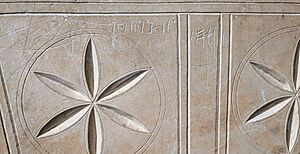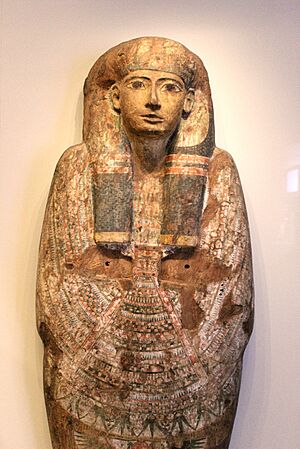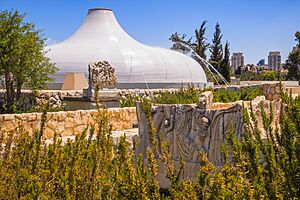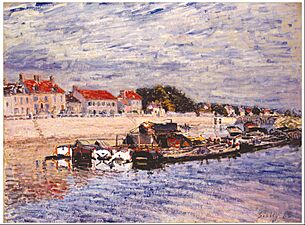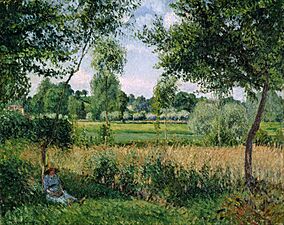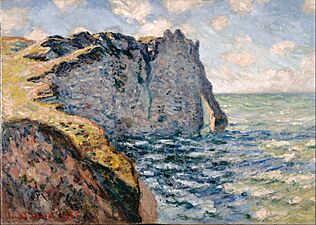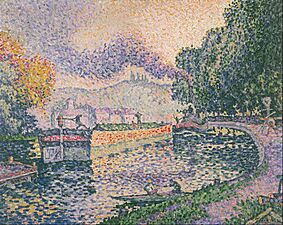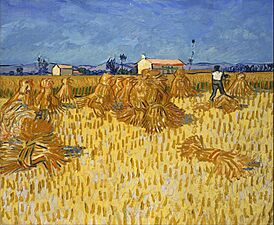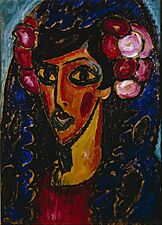Israel Museum facts for kids
 |
|

Aerial photograph of the Israel Museum, with the Knesset building in the background
|
|
| Established | May 1965 |
|---|---|
| Location | Rupin 11 Givat Ram Jerusalem, Israel |
| Type | Art and history |
| Key holdings | Dead Sea Scrolls, Holyland Model of Jerusalem, Mosaic of Rehob, Pilate stone, Tel Dan Inscription, Tzedek ve-Shalom, Venus of Berekhat Ram |
| Collections | Archaeology, Jewish Art, Fine Art |
| Collection size | Approx. 500,000 (2021) |
| Visitors | More than 900,000 (2012) |
| Public transit access | Israel Museum/Wise |
The Israel Museum is a famous art and archaeology museum in Jerusalem, Israel. It opened in 1965 and is the largest cultural place in Israel. It is also one of the world's top museums that cover many different subjects. The museum sits on a hill in the Givat Ram area of Jerusalem. It is close to other important places like the Knesset (Israel's parliament) and the Hebrew University of Jerusalem.
The museum has about 500,000 items in its collection. These include the best collections of ancient objects from the Holy Land. It also has a huge collection of Jewish art and items showing Jewish life. Plus, there are many beautiful artworks from all over the world. These artworks are divided into eleven different sections.
Some special items you can see are the Venus of Berekhat Ram, which is a very old stone figure. There's also a 1736 synagogue from Suriname that was moved inside the museum. You can also see ancient necklaces worn by Jewish brides from Yemen. A beautiful Islamic prayer niche from 17th-century Persia is also on display. A unique building shaped like an urn, called the Shrine of the Book, holds the Dead Sea Scrolls. These are the oldest known biblical writings.
Contents
Museum History
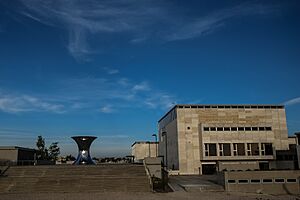
Teddy Kollek, who was the mayor of Jerusalem, was the main person who helped create the Israel Museum. He wanted to build one of the best art and archaeology museums in the world. The museum shows items from ancient times all the way to today. It has special sections for Archaeology, Fine Arts, and Jewish Art and Life.
Since it opened in May 1965, the museum has collected almost 500,000 objects. These items show a wide range of cultures from around the world. The museum buildings were first designed by architect Alfred Mansfeld. In 2010, the museum finished a big renovation project. This project cost $100 million and doubled the space for its exhibits. The different parts of the museum were rebuilt and connected by a new entrance.
Exploring Ancient History
The Samuel and Saidye Bronfman Archaeology Wing tells the story of the ancient Land of Israel. This land was home to many different cultures and religions. The museum has the world's best collection of archaeological finds from this area. The wing is set up in time order, from prehistoric times to the Ottoman Empire. It shows seven "chapters" of this ancient story.
You can see important historical events, amazing cultural achievements, and new technologies. The exhibits also give a peek into the daily lives of people who lived in the region long ago. Some special items include the Pilate stone and the "House of David" inscription from the 9th century BCE. You can also see a beautiful Mosaic of Rehob from the 3rd century CE.
Shrine of the Book
The Shrine of the Book is a very special part of the museum. It is home to the Dead Sea Scrolls. These are the oldest known copies of biblical writings in the world. It also has other rare old biblical books. The scrolls were found between 1947 and 1956 in caves near Qumran.
The building itself is unique. It has a white dome that sits over a building mostly underground. The white dome is reflected in a pool of water around it. Across from the white dome is a black wall made of basalt. The colors and shapes of the building represent ideas from one of the scrolls. The white dome stands for "Sons of Light," and the black wall stands for "Sons of Darkness." The inside of the Shrine looks like the caves where the scrolls were found. The building was designed by Armand Bartos and Frederick Kiesler and opened in 1965.
Because the scrolls are very old and fragile, they cannot be shown all the time. They are rotated, meaning different scrolls are displayed for a few months, then rested in a special storage room. The museum also has the Aleppo Codex, which is a very old Hebrew Bible from the 10th century.
Jerusalem Model
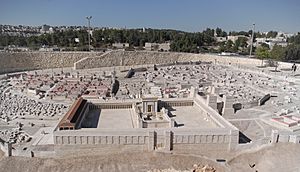
Next to the Shrine of the Book, you'll find a large model of Jerusalem as it looked in the Second Temple Period. This model shows what the city looked like before the Romans destroyed it in 70 CE. It helps visitors understand the time when the Dead Sea Scrolls were written. The model includes a detailed copy of Herod's Temple. It used to be at the Holyland Hotel but is now a permanent part of the museum's campus.
Art from Around the World
The Edmond and Lily Safra Fine Arts Wing displays art from many different times and cultures. This wing shows how art connects across ages and places. It includes European Art, Modern Art, Contemporary Art, and Israeli Art. You can also see art from Africa, Oceania, the Americas, and Asia.
The exhibits are set up to show how different artworks are similar or share themes. This helps visitors see connections between art from various times and places. It also helps everyone appreciate the common ideas that run through human culture. This wing now has the museum's first permanent galleries for Israeli art. It also has much more space for modern art and a large area for changing exhibits of contemporary art.
European, Modern, and Israeli Art
The Israel Museum has a huge collection of paintings. These paintings come from many different time periods, styles, and regions. You can see works by famous international artists like Rembrandt and Camille Pissarro. There are also paintings by important Israeli and Jewish artists such as Marc Chagall and Reuven Rubin.
The museum is very dedicated to Israeli art. As Israel's national museum, it helps protect Israel's artistic history. It collects works by Israeli artists and supports them in their careers. The Israeli Art collection covers art from the late 19th century to today. It shows how Israel's culture has grown through visual arts.
Jewish Art and Life
The Jack, Joseph, and Morton Mandel Wing for Jewish Art and Life shows items from Jewish communities worldwide. These items cover centuries, from the Middle Ages to today. The collection highlights the beauty of Jewish heritage and creativity. It also shows how other cultures influenced Jewish art where Jews lived.
This wing has many special treasures. These include rare old books, four reconstructed synagogue interiors, and many ceremonial objects. You can also see different types of clothing, jewelry, and everyday items. The exhibits explore the history of these objects and how they were used. They also show the beauty of the items and their emotional meaning.
Five main themes guide you through the galleries:
- The Rhythm of Life: Birth, Marriage, Death – This section shows how joy and sadness, life and death, and memory and hope are part of these important life moments.
- Illuminating the Script – Here you can see rare Hebrew manuscripts from the Middle Ages and Renaissance. It shows their history and amazing artistry.
- The Synagogue Route: Holiness and Beauty – Four restored synagogue interiors from Europe, Asia, and the Americas are displayed. Along with Torah scroll ornaments, they show how Jewish religious buildings and objects are both similar and different.
- The Cycle of the Jewish Year – This part shows how the Sabbath and Jewish holidays are celebrated. It also includes items for special days in Israel. Many beautiful objects and artworks have been created for these times.
- Costume and Jewelry: A Matter of Identity – This section explores how where people live, their customs, and religious rules shaped the rich variety of Jewish clothing and jewelry from East and West.
Art Garden
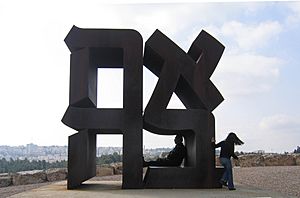
The Billy Rose Art Garden is a large outdoor space with modern and abstract sculptures. This garden was designed by Japanese American sculptor Isamu Noguchi. It is considered one of the best outdoor sculpture settings from the 20th century. The garden mixes an Oriental landscape with an ancient Jerusalem hillside. It shows how modern Western sculpture has developed. You can see works by famous artists like Jacques Lipchitz, Henry Moore, Pablo Picasso, and Auguste Rodin.
Youth Wing
The Ruth Youth Wing for Art Education opened in 1966. It is special because of its size and the many activities it offers. More than 100,000 schoolchildren visit each year. It has art studios, classrooms, a library of children's books, and a recycling room. Special programs help Arab and Jewish students understand each other better. The wing also has art exhibits by Israeli and international artists. There are many workshops for both children and adults.
Other Museum Locations
Besides its main campus, the Israel Museum also runs two other locations:
- The Rockefeller Archaeological Museum: This museum opened in 1938. It displays ancient objects found mostly in excavations in Mandatory Palestine during the 1920s and 1930s.
- Ticho House: This historic house and garden offers ongoing exhibits by younger Israeli artists.
Museum Operations
The Israel Museum gets only a small part of its money from the government. It has to raise most of its yearly budget itself. This means donations and support from groups around the world are very important. For example, the American Friends of the Israel Museum group has raised a lot of money and donated many artworks over the years.
In 2012, about 827,000 people visited the museum.
Prizes
The museum gives out prizes, like the Jesselson Prize for Contemporary Judaica Design. This prize recognizes excellent designs for Jewish ritual objects.
Recent Incident
On October 5, 2023, a tourist was arrested at the museum. He damaged a marble head of the Greek goddess Athena and a statue of a griffin. Police said he believed the items were against his religious beliefs. The damaged items, both from the Second Century CE, are being restored.
Gallery
See also
 In Spanish: Museo de Israel para niños
In Spanish: Museo de Israel para niños
- Bible Lands Museum – another archaeology museum in Jerusalem
- National Library of Israel – a library collecting cultural treasures of Israel and Jewish heritage, located nearby
- Eretz Israel Museum – a history and art museum in Tel Aviv


